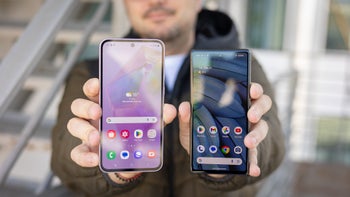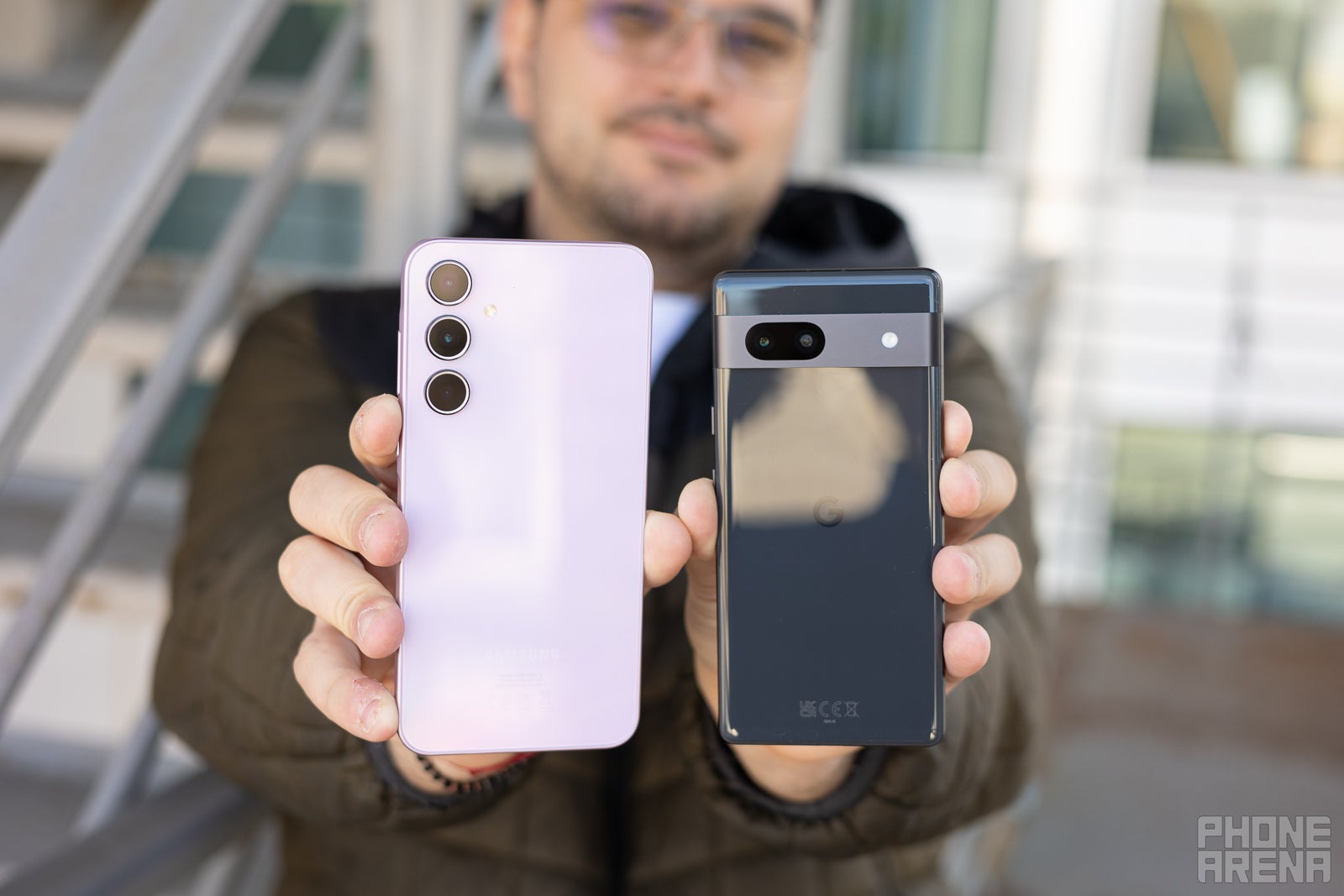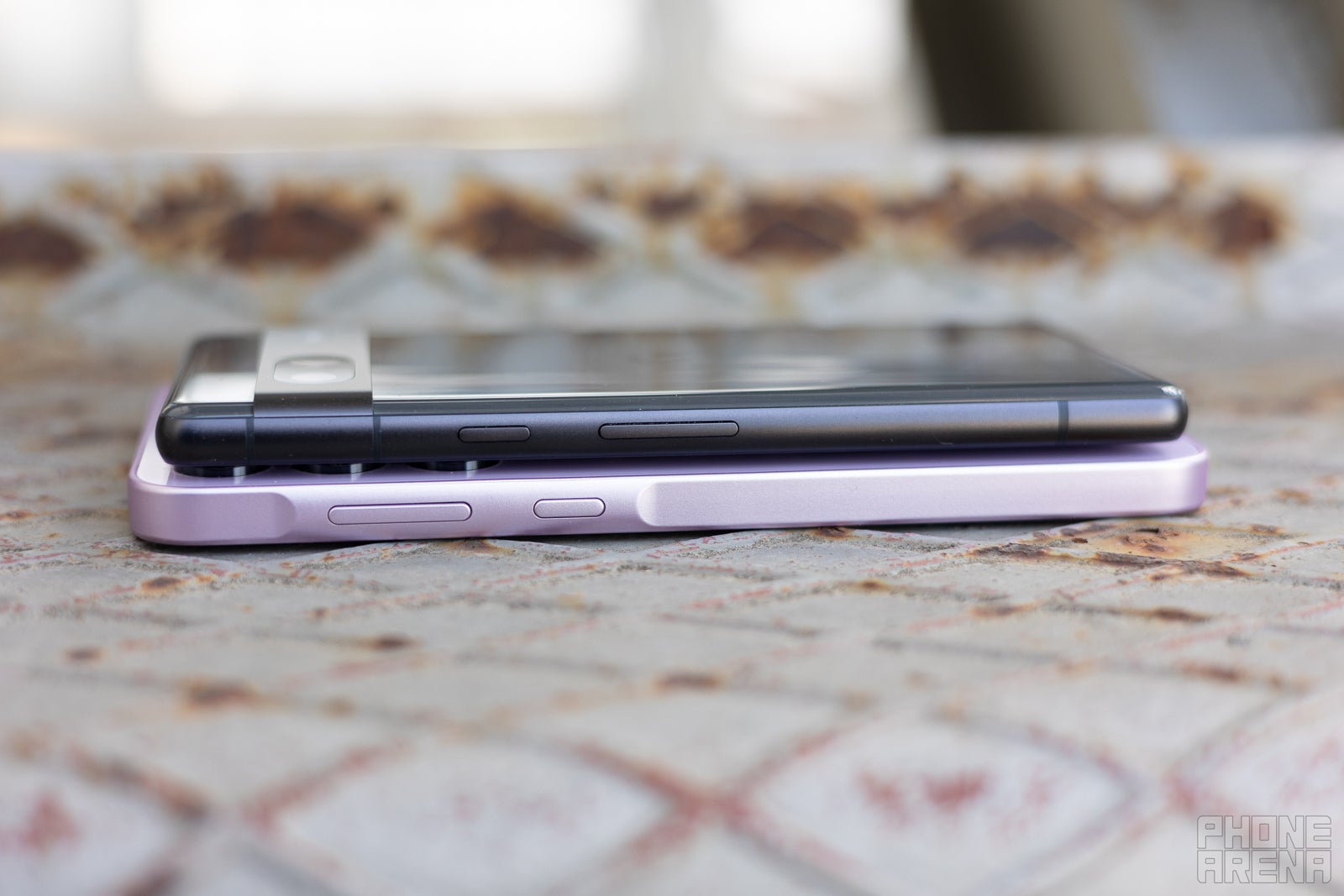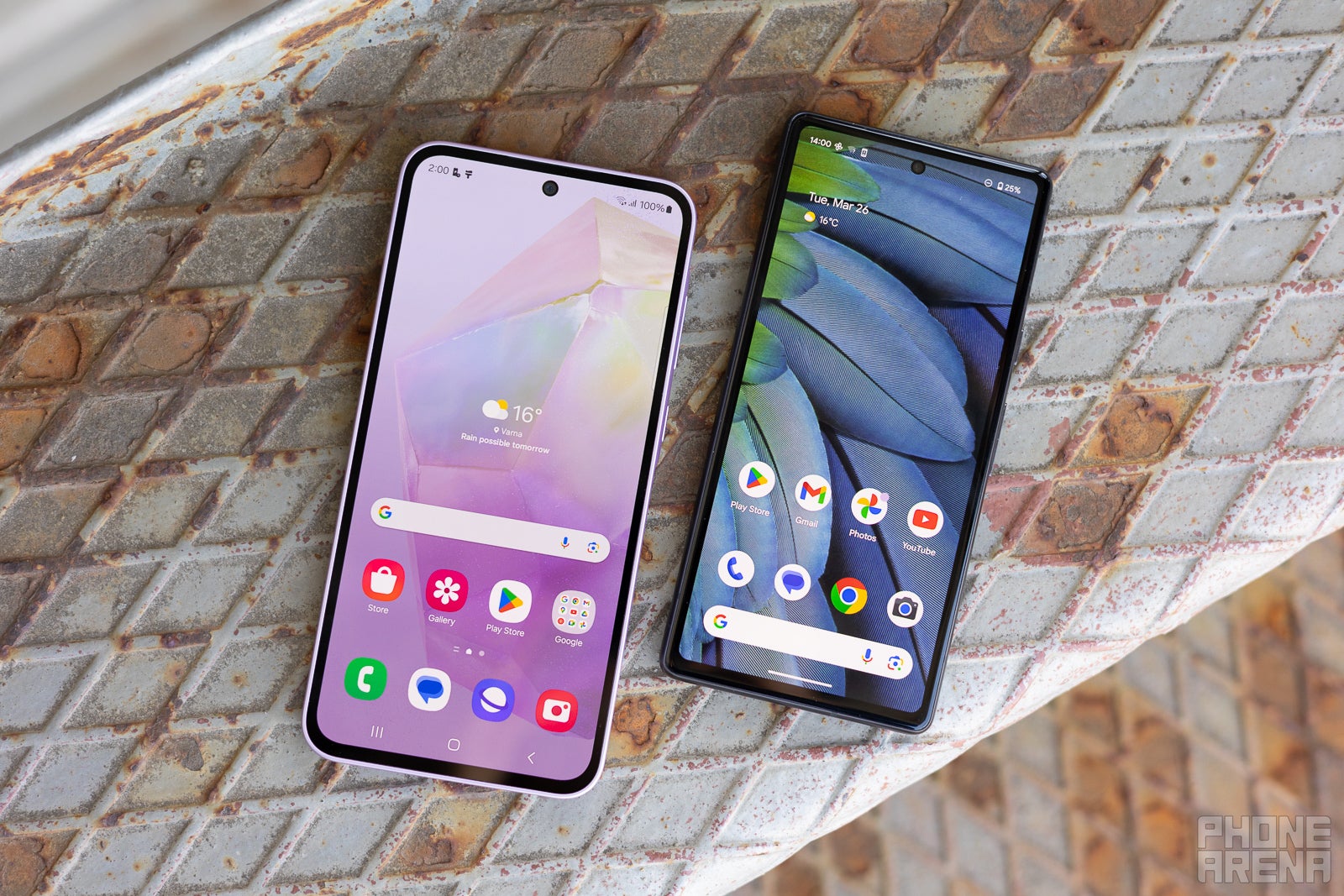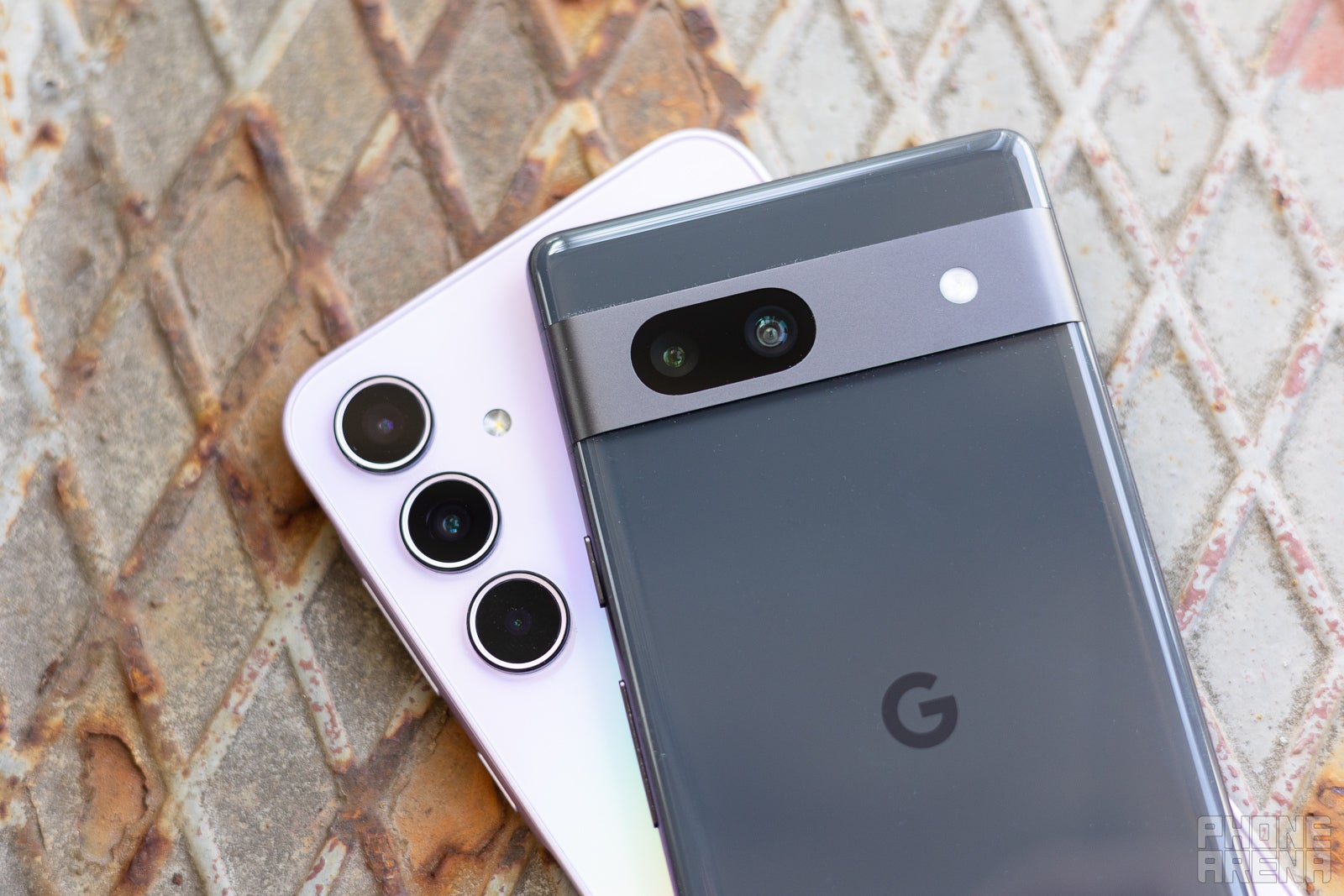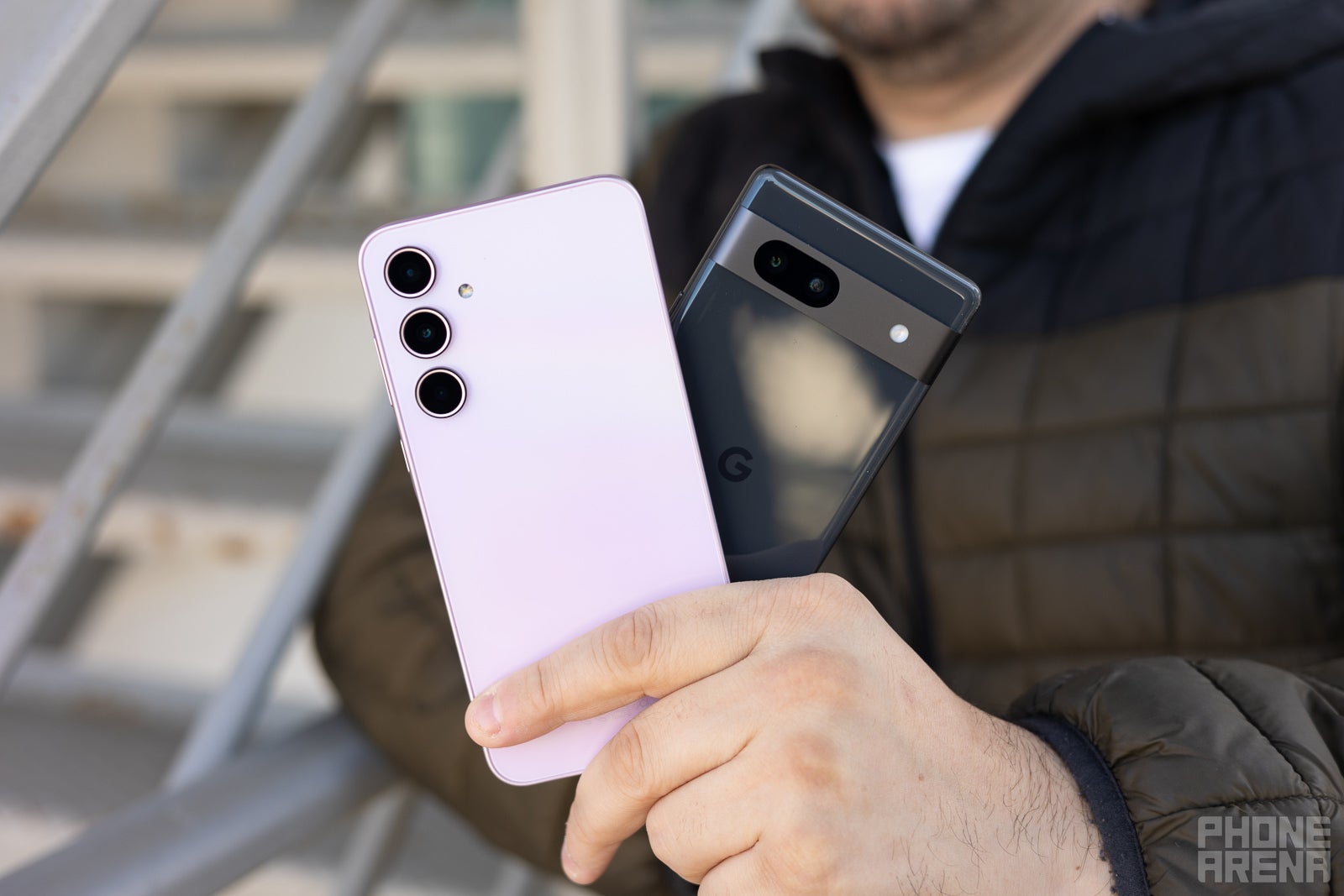Intro
The new Galaxy A35 is Samsung’s mid-range offering for the US market in early 2024, surprisingly stealing the crown from the Galaxy A5x series. Those used to be the company’s hard-hitters when it comes to non-flagship phones.
Meanwhile, the mid-range segment is also occupied by one device that’s extremely challenging to ignore––the
Google Pixel 7a. The smartest mid-ranger around boasts most of the hardware and software features that made the
Pixel 7 flagship lineup so successful. Pair that with the superb and quite affordable price tag, and you’re in for a treat.
So, how does the Galaxy A35 5G compare against the Pixel 7a?
Galaxy A35 5G vs Google Pixel 7a differences explained:
| Galaxy A35 5G |
Google Pixel 7a |
| Larger but not much heavier device |
A more compact phone |
| Larger and smoother 6.6-inch display |
A smaller 6.1-inch screen with less impressive 90Hz refresh rate |
| Triple camera, including a macro, but main camera is 50MP |
Dual camera, main camera is 64MP |
| Less memory in the base version (6GB) |
More memory in the base version (8GB) |
| Equal native storage (128GB) and microSD card slot |
128GB of storage in here as well |
| Larger 5,000mAh battery that will potentially deliver better battery life |
A smaller 4,385mAh battery |
| No wireless charging, but faster wired charging |
Slow wired charging, but wireless charging |
Table of Contents:
Design and Display Quality
Not much going on in terms of design
Don’t hold your breath, as neither of these two devices will rock your world as far as design goes.
The Google mid-ranger has it much better, though. It features an aluminum frame, while the Galaxy A35 is an unapologetically plastic affair. The Samsung device also features a mostly flat design, whereas the Pixel 7a has a slightly curved side frame that feels much better in the hand.
Each of these two phones also has a unique design quirk that sets it apart. For the
Samsung phone, it’s the new Key Island bump on the right side of the frame, which houses the power and volume buttons. It’s a design feature that Samsung is currently pushing across its whole mid-range lineup.
On the other hand, the
Pixel 7a has the well-pronounced rear camera strip, which Google calls 3D Metal Visor. It has been a distinct Pixel design feature since the
Pixel 6 lineup, and we imagine that Google will build on this feature going forward.
Both the Pixel 7a and the Galaxy A35 also have IP67 water- and dust-resistance on board. The Pixel 7a comes in Charcoal, Snow, Sea, and Coral colors. The Galaxy A35 5G, on the other hand, comes in Awesome Iceblue, Awesome Lilac, and Awesome Navy.
As far as size is concerned, there’s no denying that the Galaxy A35 is the larger device, but from a weight perspective, the
Pixel 7a ranks pretty close. That said, you get more screen real estate with the
Samsung phone, which mostly matches the company’s current
Galaxy S24 Plus flagship.
Speaking of displays, the Galaxy A35 5G lands with a 6.6-inch Super AMOLED display, while the Pixel 7a has a 6.1-inch OLED screen. While there’s no palpable difference in perceived screen resolution and sharpness, there’s a difference in the smoothness. Google’s phone only supports up to 90Hz of refresh rate, while the Samsung device is noticeably smoother at up to 120Hz. Both displays support HDR, but don’t expect excessively high maximum brightness. This feature hasn’t trickled down to the mid-range world just yet.
Display Measurements:
As per our display benchmarks, the Galaxy A35 5G has a slightly better display than the Pixel 7a, with higher maximum and lower minimum brightness.
Performance and Software
Featherweight fight
It’s another iteration of a modern classic, the Exynos vs Tensor bout!
While the Google Tensor G2 that powers the
Pixel 7a is the same device that can be found in the
Pixel 7,
Pixel 7 Pro, and
Pixel Fold flagship phones, it’s not what you’d call a thoroughbred champ. The strength of the Tensor lies in its AI and ML chops.
At the same time, the Exynos 1380 chip that’s ticking inside the Galaxy A35 5G is surely not a performance beast either. We’ve already seen this chip in action on last year’s Galaxy A54, and suffice to say, we weren’t impressed. Its performance was mostly hit or miss, with noticeable micro-jitters and some lag while navigating the interface. Par for the course as far as mid-range Samsung phones go.
According to our benchmark tests, the Galaxy A35 is soundly beaten by the Google Pixel 7a and its Tensor chip. This is true in both the GeekBench 6 and 3DMark benchmarks, which essentially means that the Google phone is the superior machine when it comes to both everyday advanced performance and gaming.
Memory-wise, we have 6GB of storage on the Galaxy A35, while the Pixel 7a soars with 8GB of memory. This suggests that the Google phone could be a better multi-tasker. In terms of native storage, both phones start with 128GB of storage. However, the Samsung mid-ranger has been dealt a significantly better card, as it’s also available with 256GB of storage and also comes with a microSD card slot.
Camera
Can the Galaxy A35 stand up to the Pixel?
The
Pixel 7a comes along with a new dual camera in comparison with its predecessor, the
Pixel 6a. There are new higher-res sensors on both the wide and ultra-wide cameras at the rear, which deliver the recognizable Pixel camera look. Photography-wise, the
Pixel 7a is definitely among the mid-range devices with the most capable cameras, and a big reason for that are the AI-enhanced camera features.
Meanwhile, the Galaxy A35 comes with a triple camera setup, but for most intents and purposes, you can easily perceive it as a dual-camera one. See, there are your regular wide and ultra-wide cameras, but the third one is a macro unit. We are not particularly big fans of these cameras, as they are usually useless at best and offer an extremely slim benefit.
Audio Quality and Haptics
The Pixel 7a was a fun phone to listen to, with more than decent audio quality. The Galaxy A35 delivers okay audio, it sometimes sounds a bit muffled so you might not enjoy music as much as you would when listening to the Pixel 7a.
Haptics are one area in which the Pixel 7a could shine. It delivers exact and precise vibrations. These are never a strong suit of Samsung’s mid-rangers, which usually deliver mushy vibrations.
Battery Life and Charging
Larges is always better, but what about battery life?
The Galaxy A35 5G comes with a large 5,000mAh battery, the standard on many flagships these days. Given the efficiency of the Exynos 1380, we are cautiously optimistic that the Galaxy A35 5G will deliver decent battery life and could beat the Pixel 7a in this important aspect.
Meanwhile, in Google’s camp, the
Pixel 7a boasts a 4,385mAh battery, and this one surprised us with its more than decent battery life. In our custom battery tests, which are conducted at 200 nits of manually set display brightness, the
Pixel 7a fared extremely well and eked out a victory against some of its opponents, like the
iPhone 14,
Pixel 7, and
Pixel 6a.
PhoneArena Battery Test Results:
Well, surprisingly, the Pixel 7a beats the Galaxy A35 in two of our three custom tests, all of which are conducted with the display manually set to 200 nits of brightness. In our web browsing test, which emulates a regular browsing experience, the Pixel 7a achieves 15 hours and a half, while the Galaxy A35 is roughly an hour behind. The Google phone is victorious in our video streaming test, beating the Galaxy. The only consolation prize for the Samsung phone is our 3D gaming test, in which it beats the Pixel 7a. However, you’d have a better time playing games on the Pixel 7a regardless of the lower battery life.
In terms of charging speeds, the
Pixel 7a supports slower wired charging, just 18W, and it charges very slowly: it takes two hours for a complete charge, which is too slow. There’s wireless charging on the
Pixel 7a, but it’s also very slow – just 7.5W. Meanwhile, the Galaxy A35 doesn’t have wireless charging, but could charge faster as it has 25W wired charging support (just as fast as the
Galaxy S24).
PhoneArena Charging Test Results:
As per our charging tests, the Galaxy A35 5G charges significantly faster than the Pixel 7a, saving more than half an hour and completing a full charge in around 90 minutes, which is a decent result.
Specs Comparison
| Specs |
Galaxy A35 5G |
Pixel 7a |
| Dimensions |
161.7 x 78.0 x 8.2 mm |
152.4 x 72.9 x 9 mm |
| Weight |
209gr |
193gr |
| Screen |
6.6-inch Super AMOLED 120Hz |
6.1-inch OLED 90Hz |
| Processor |
Exynos 1380 (5nm) |
Google Tensor G2 (5nm) |
| RAM, Storage and Price |
6GB RAM, 128GB/256GB storage, microSD card slot |
8GB RAM, 128GB storage |
| Cameras |
Wide: 50MP F1.8
Ultra-wide: 8MP F2.2
Macro: 5MP F2.4
Front: 13MP |
Wide: 64MP F1.9
Ultra-wide: 13MP F2.2
Front: 13MP F2.2 |
| Battery Size |
5,000mAh |
4,385mAh |
| Charging Speeds |
25W wired charging |
18W wired charging
7.5W wireless charging |
Summary and Final Verdict
The
Pixel 7a is one of the gems on the mid-range market, one that shouldn’t be ignored. With all the essential bells and whistles of a regular Pixel phone, it’s a very safe buy that is still viable on the eve of the
Pixel 8a announcement. Definitely one of our favorite mid-rangers of 2023.
At the same time, Samsung vastly changed its device strategy by not releasing the
Galaxy A55 5G, but instead releasing the Galaxy A35 5G in its place. The two are similar as far as features go, so it’s mostly semantics. With the new mid-ranger, Samsung has the unique opportunity to fortify its holding on the mid-range market. Let’s see how things unravel for the company.
